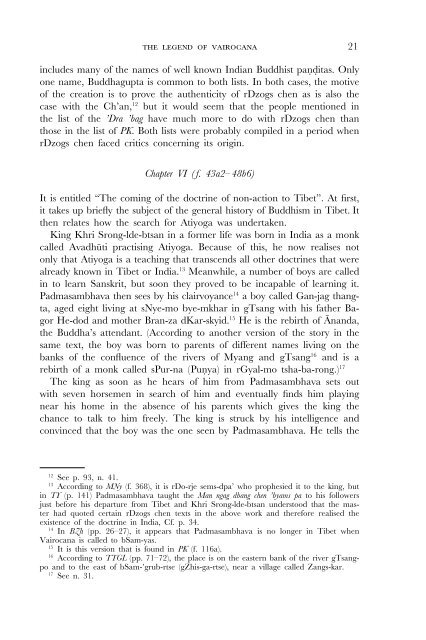You also want an ePaper? Increase the reach of your titles
YUMPU automatically turns print PDFs into web optimized ePapers that Google loves.
the legend of vairocana 21<br />
includes many of the names of well known Indian Buddhist pa»∂itas. Only<br />
one name, Buddhagupta is common to both lists. In both cases, the motive<br />
of the creation is to prove the authenticity of rDzogs chen as is also the<br />
case with the Ch’an, 12 but it would seem that the people mentioned in<br />
the list of the ’Dra ’bag have much more to do with rDzogs chen than<br />
those in the list of PK. Both lists were probably compiled in a period when<br />
rDzogs chen faced critics concerning its origin.<br />
Chapter VI ( f. 43a2–48b6)<br />
It is entitled “The coming of the doctrine of non-action to Tibet”. At first,<br />
it takes up briefly the subject of the general history of Buddhism in Tibet. It<br />
then relates how the search for Atiyoga was undertaken.<br />
King Khri Srong-lde-btsan in a former life was born in India as a monk<br />
called Avadhùti practising Atiyoga. Because of this, he now realises not<br />
only that Atiyoga is a teaching that transcends all other doctrines that were<br />
already known in Tibet or India. 13 Meanwhile, a number of boys are called<br />
in to learn Sanskrit, but soon they proved to be incapable of learning it.<br />
Padmasambhava then sees by his clairvoyance 14 a boy called Gan-jag thangta,<br />
aged eight living at sNye-mo bye-mkhar in gTsang with his father Bagor<br />
He-dod and mother Bran-za dKar-skyid. 15 He is the rebirth of Ànanda,<br />
the Buddha’s attendant. (According to another version of the story in the<br />
same text, the boy was born to parents of different names living on the<br />
banks of the confluence of the rivers of Myang and gTsang 16 and is a<br />
rebirth of a monk called sPur-na (Pu»ya) in rGyal-mo tsha-ba-rong.) 17<br />
The king as soon as he hears of him from Padmasambhava sets out<br />
with seven horsemen in search of him and eventually finds him playing<br />
near his home in the absence of his parents which gives the king the<br />
chance to talk to him freely. The king is struck by his intelligence and<br />
convinced that the boy was the one seen by Padmasambhava. He tells the<br />
12 See p. 93, n. 41.<br />
13 According to MNy (f. 368), it is rDo-rje sems-dpa’ who prophesied it to the king, but<br />
in TY (p. 141) Padmasambhava taught the Man ngag dbang chen ’byams pa to his followers<br />
just before his departure from Tibet and Khri Srong-lde-btsan understood that the master<br />
had quoted certain rDzogs chen texts in the above work and therefore realised the<br />
existence of the doctrine in India, Cf. p. 34.<br />
14 In BZh (pp. 26–27), it appears that Padmasambhava is no longer in Tibet when<br />
Vairocana is called to bSam-yas.<br />
15 It is this version that is found in PK (f. 116a).<br />
16 According to TTGL (pp. 71–72), the place is on the eastern bank of the river gTsangpo<br />
and to the east of bSam-’grub-rtse (gZhis-ga-rtse), near a village called Zangs-kar.<br />
17 See n. 31.

















